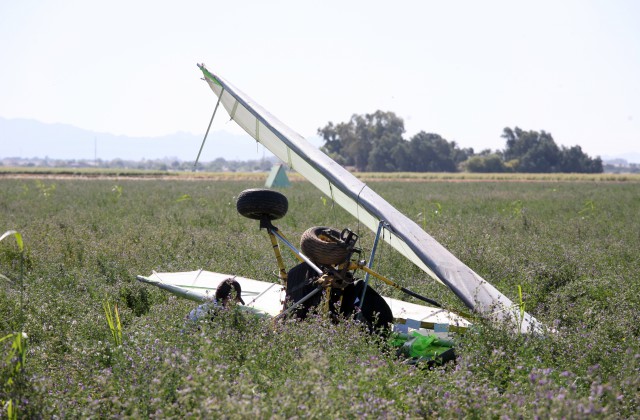
SONOYTA,
They usually fly at night with no lights and often,
they’re guided only by the dim screen of a handheld satellite
navigation tool, looking for a precise spot in the desert.
The smugglers generally don’t land. They’ve modified
the ultralight aircraft with drop baskets that can hold 150 to 250
pounds of marijuana wrapped in brick-sized units and covered in
plastic. They move a lever, and the bricks fall to the desert for
ground crews to pick up and smuggle onward across the country.
It’s a perilous tactic, and pilots can break limbs or die in crashes.
“It’s a fairly risky endeavor for them to try to do
this. … They do fly close to the ground, which can be dangerous
because of power lines,” said
Ultralight aircraft evolved out of hang gliders, and the
doesn’t classify them as “aircraft.” That legal loophole allows dopers
to bring in sizable loads of marijuana and get lighter jail terms than
if they’d used a car or small airplane.
“It’s a pretty new phenomenon,” said
A Democratic congresswoman from
proposed last month to close that loophole with an Ultralight Smuggling
Prevention Act. Giffords called ultralights “the latest threat to
border security.”
Giffords said the Customs and Border Protection’s Air and Marine Operation Center in
On
Aerospace Defense Command scrambled two F-16 jet fighters to intercept
an ultralight aircraft crossing into
Ultralights have fabric wings attached to aluminum
tubing. Small two-stroke engines that sound much like a whining lawn
mower, power rear propellers. The pilots sit in sling seats that give
the vehicles the appearance of winged tricycles.
“I hate to say it, but those things are very stealthy aircraft,” said Sgt.
When Mexican smugglers began using small airplanes
in the 1980s and 1990s, the U.S. government responded by deploying six
Aerostat surveillance blimps to strategic border locations, thwarting
air smuggling for many years.
But the Aerostats, tethered by 15,000-foot cables,
return to their ground pads at night to avoid snaring legal aircraft
that might get entangled in the cables.
To avoid ground-based radar at night, the
ultralights generally fly low, tracing routes over illuminated
highways, although authorities have tracked them flying at altitudes of
12,000 feet.
Giffords said some of the smugglers’ aircraft have been detected “flying up to 200 miles into our country from
Both humanitarian concerns and legal considerations prevent law enforcement from firing on the ultralights when they spot them.
“There are rules on deadly force,” Gordon said,
noting that the ultralight pilots wouldn’t survive a strafing. “If you
shoot them, you’re going to kill them.”
Such legal considerations give the traffickers leeway.
“They don’t care about flying with their lights on.
They don’t care about flying at the proper designated altitudes for
aircraft. They don’t care about flying through controlled air spaces,”
Pearson said.
“The first thing out of their mouth is, ‘How much weight can it carry?’ ” Cooper said.
Drug gangs in
“They are getting some ‘gofer’ out there to jump on these things, and then it’s, ‘Hasta la vista, baby,’ ” Cooper said.
The vehicles are usually overloaded, making them
unstable. “If you hit some turbulence, the aircraft can start to break
apart,” he said.
In one of the earliest known incidents of the use of ultralights for drug smuggling,
Under the toughened measures in Giffords’ proposal, smugglers could be given sentences of up to 20 years and
Iriarte’s attorney,
“My understanding is that they are not all that difficult to drive. It’s not much more difficult than a motorcycle,” he said.
Pearson, the sheriff’s sergeant, said traffickers
might not stop at smuggling marijuana. They will also bring cocaine and
heroin — or explosives.
“Here’s my big concern,” Pearson said. “Four hundred
pounds of C-4 (plastic explosive) will do a heck of a lot of damage. If
that were a light airplane, or if that were a 757 talking to someone, I
bet the
———
ANSWERS TO QUESTIONS ABOUT ULTRALIGHT AIRCRAFT
Q: What is an ultralight aircraft?
A. The first ultralight aircraft were essentially
powered hang gliders. Now there are several different designs, although
the most popular still have a hang glider-style wing. Suspended below
is a three-wheeled carriage that holds a pilot and the engine and a
rear-facing propeller.
U.S. regulations say ultralights must have a fuel
capacity of less than 5 gallons, an empty weight of less than 254
pounds and a top speed of 64 mph. Anything larger than that is
categorized as a light-sport aircraft.
Q: How do they take off?
A: Ultralights can take off on flat grass or dirt
strips in 200 feet or less. They don’t need to take off from a bluff as
hang gliders do.
Q: How far can they go?
A: Most tricycle-style ultralights use around 3 gallons of fuel per hour, giving them a range of about 200 miles.
Q: Do you need a license?
A: No license is required for a single-seat
ultralight. It typically takes eight to 12 hours to gain necessary
training to fly a single seat ultralight.
Q: How much do they cost?
A: A typical one-seat ultralight sells for around
Q: How do Mexican smugglers modify their ultralights?
A: Smugglers can use engines with more horsepower to
go as fast as 90 miles per hour, and place larger fuel tanks on the
vehicles. They also build cargo cages to hold bricks of marijuana or
narcotics.
———
(c) 2010, McClatchy-Tribune Information Services.
Visit the













